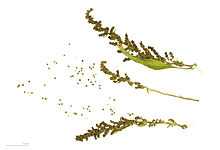
Dysphania ambrosioides
Did you know...
SOS Children volunteers helped choose articles and made other curriculum material Child sponsorship helps children one by one http://www.sponsor-a-child.org.uk/.
| Epazote | |
|---|---|
 |
|
| Scientific classification | |
| Kingdom: | Plantae |
| (unranked): | Angiosperms |
| (unranked): | Eudicots |
| (unranked): | Core eudicots |
| Order: | Caryophyllales |
| Family: | Amaranthaceae |
| Subfamily: | Chenopodioideae |
| Tribe: | Dysphanieae |
| Genus: | Dysphania |
| Species: | D. ambrosioides |
| Binomial name | |
| Dysphania ambrosioides (L.) Mosyakin & Clemants |
|
| Synonyms | |
|
Chenopodium ambrosioides, Chenopodium ambrosiodes |
|
Epazote, wormseed, Jesuit's tea, Mexican tea, Paico or Herba Sancti Mariæ (Dysphania ambrosioides, formerly Chenopodium ambrosioides) is an herb native to Central America, South America, and southern Mexico.
Growth
It is an annual or short-lived perennial plant, growing to 1.2 m tall, irregularly branched, with oblong- lanceolate leaves up to 12 cm long. The flowers are small and green, produced in a branched panicle at the apex of the stem.
As well as in its native areas, it is grown in warm temperate to subtropical areas of Europe and the United States ( Missouri, New England, Eastern United States), sometimes becoming an invasive weed.
Etymology
The common Spanish name, epazote (sometimes spelled and pronounced ipasote or ypasote), is derived from Nahuatl: epazōtl (pronounced [eˈpasoːt͡ɬ]).
Usage
Culinary uses
Epazote is used as a leaf vegetable, an herb and a tisane for its pungent flavor. Raw, it has a resinous, medicinal pungency, similar to anise, fennel, or even tarragon, but stronger. Epazote's fragrance is strong but difficult to describe. A common analogy is to turpentine or creosote. It has also been compared to citrus, savory, or mint.
Although it is traditionally used with black beans for flavor and its carminative properties, it is also sometimes used to flavor other traditional Mexican dishes as well: it can be used to season quesadillas and sopes (especially those containing huitlacoche), soups, mole de olla, tamales with cheese and chile, chilaquiles, eggs and potatoes and enchiladas.
Medicinal uses
Epazote is commonly believed to prevent flatulence caused by eating beans and is therefore used to season them. It is also used in the treatment of amenorrhea, dysmenorrhea, malaria, chorea, hysteria, catarrh, and asthma.
Although it is used as an anti-cancer herb, and some of its chemical constituents have been shown in the laboratory to affect certain cancer cell lines, it has also been reported to be highly carcinogenic in rats. A Nigerian group, however, concluded in 2007 that it is neither mutagenic nor cytotoxic.
Oil of chenopodium is derived from this plant. It is antihelminthic, that is, it kills intestinal worms, and was once listed for this use in the US Pharmacopeia. It is also cited as an antispasmodic and abortifacient.
Epazote essential oil contains ascaridole (up to 70%), limonene, p-cymene, and smaller amounts of numerous other monoterpenes and monoterpene derivatives ( α-pinene, myrcene, terpinene, thymol, camphor and trans-isocarveol). Ascaridole (1,4-peroxido-p-menth-2-ene) is rather an uncommon constituent of spices; another plant owing much of its character to this monoterpene peroxide is boldo. Ascaridole is toxic and has a pungent, not very pleasant flavor; in pure form, it is an explosive sensitive to shock. Allegedly, ascaridole content is lower in epazote from Mexico than in epazote grown in Europe or Asia.
Agricultural use
The essential oils of Epazote contain Terpene compounds, some of which have natural pesticide capabilities. The company AgraQuest Inc. of Davis, California, synthetically manufactures a proprietary blend of identical compounds for use in their agricultural pesticide product Requiem. It is not licensed for residential use.
Companion plant
Epazote not only contains terpene compounds, also delivers partial protection to nearby plants simply by masking their scent to some insects, making it a useful companion plant. Its small flowers may also attract some predatory wasps and flies.

